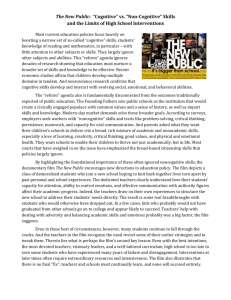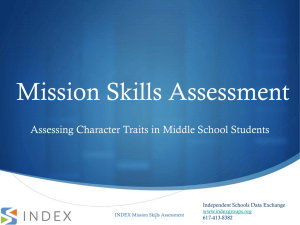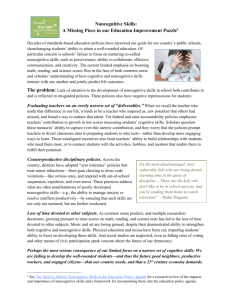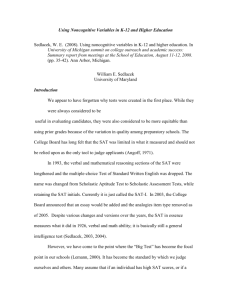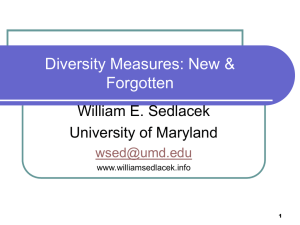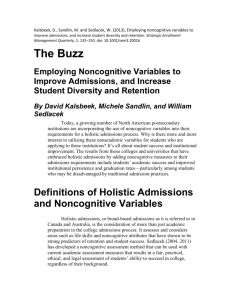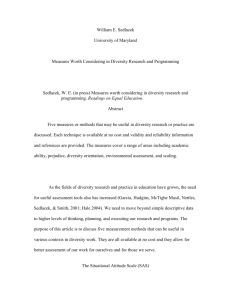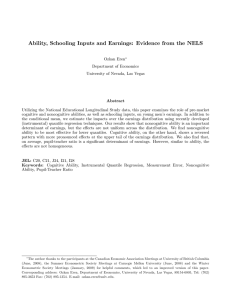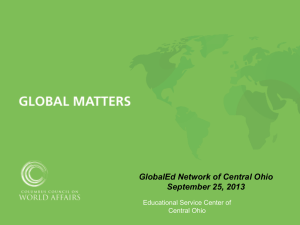Assessing Noncognitive Variables - Center for Enrollment Research
advertisement
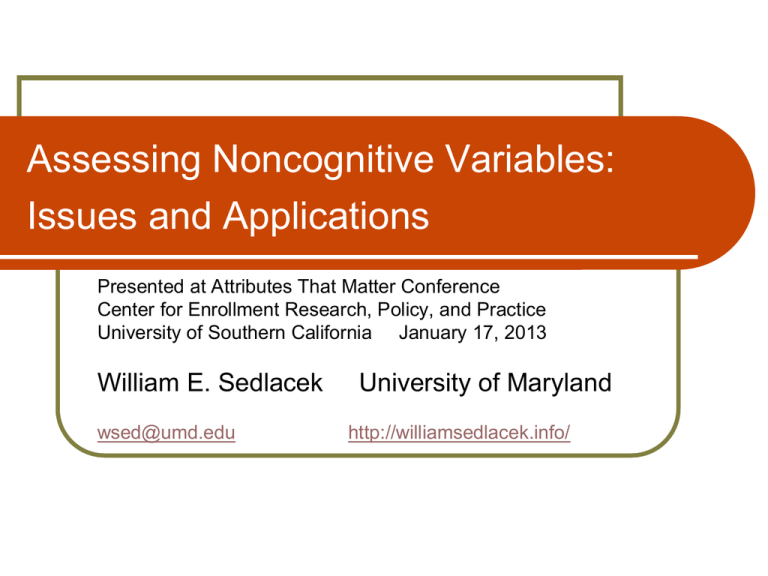
Assessing Noncognitive Variables: Issues and Applications Presented at Attributes That Matter Conference Center for Enrollment Research, Policy, and Practice University of Southern California January 17, 2013 William E. Sedlacek wsed@umd.edu University of Maryland http://williamsedlacek.info/ Current Issues in Admissions Restriction of Range Tests Grade Inflation Courses Diversity Three Musketeers Problem Range of Abilities Sternberg- Intelligence Types Componential Ability to interpret information hierarchically in a well defined and unchanging context. Standardized tests. Experiential Ability to interpret information in changing contexts, be creative. Standardized tests DO NOT measure. Contextual Ability to adapt to a changing environment, ability to handle & negotiate the system. Standardized tests DO NOT measure. Noncognitive Variables Self- Concept Demonstrates confidence, strength of character, determination, and independence. Realistic Self- Appraisal Recognizes and accepts any strengths and deficiencies, especially academic, and works hard at self-development. Recognizes need to broaden his/her individuality. Handling System/Racism Exhibits a realistic view of the system based upon personal experience of racism. Committed to improving the existing system. Takes an assertive approach to dealing with existing wrongs, but is not hostile to society, nor is a "cop-out." Able to handle racist system. Noncognitive Variables (Contd) Leadership Long- Range Goals Seeks and takes advantage of a strong support network or has someone to turn to in a crisis or for encouragement. Community Able to respond to deferred gratification, plans ahead and sets goals. Strong Support Person Demonstrates strong leadership in any area of his/her background (e.g. church, sports, non-educational groups, gang leader, etc.). Participates and is involved in his/her community. Nontraditional Learning Acquires knowledge in sustained and/or culturally related ways in any field outside school. Advantages of Noncognitive Variable System Research based Multiple ways to assess Questionnaire (structured-short answer), interview, essay, portfolio Retention related Considers diversity, US or international Tested legally Revise to fit situation-flexible No cost Student development Admissions, financial aid, student services, teaching, advising Community building High school counselors approve Criticisms of Noncognitive Variable System “To avoid criticism, do nothing, say nothing, be nothing.” Elbert Hubbard Not a single “test”- many formats College Board says invalid Scoring not same for all Thomas et al (2007) Three Musketeers May require some scoring time Easier to get grades & test scores Need to explain to some audiences Parents, staff, faculty, alumni Key Legal Cases Farmer v. Ramsey et al.- 1998 Castañeda et al. v. U Cal Regents- 1999 Gratz and Hamacher v. Bollinger et al., 2002, and Grutter v. Bollinger et al., 2002 Fisher & Multer Michalewicz v. U of Texas2009 Oregon State program cited as “best practice” by the US Office of Civil Rights Gates Millennium Scholars -GMS African American, American Indian/Alaska Native, Asian Pacific Islander American, or Hispanic American Federal Pell Grant eligible Citizen/legal permanent resident or national of U.S. 3.3 High School GPA Curriculum Rigor Noncognitive Variables A GMS award provides: Support by covering needs unmet by other financial options Renewable awards for satisfactory progress Option to transfer Graduate school in math, science, engineering, library science, education, and public health Leadership development program 1.75 billion dollar program GMS Outcomes • • • • • • • Over 15,000 Scholars funded Freshman retention 97%; sophomore 95% 5 year program retention rate 92% 5 year graduation rate 79% (53% all 4yr schools) 6 year graduation rate 90% (57% all 4yr schools) Scholar higher education GPA mean = 3.25 Raters within each racial group trained to evaluate noncognitive variables -Alpha reliability = .92 • Scholars from 50 states & American Samoa, Guam, Federated States of Micronesia, Puerto Rico, Virgin Islands • Scholars in over 1500 colleges and universities • Scholars more likely to attend: selective, private, residential schools East Carolina University School of Dental Medicine Educate rural practitioners Select on noncognitive variables Self concept, Negotiating the system, Support person correlate highest with actual selection Faulty and staff stress how to work rural dental practice system- e system after graduation Funding from State based on working rural heath system Some Additional Programs Using Noncognitive Variables Washington State Achievers Washington DC Achievers Capital Partners for Education Washington State University Pullman Washington State University Vancouver Univ. British Columbia Business School Bowling Green State University Montgomery College Engineering Vanguard Program (NACME) University of Central Missouri DePaul University Eastern Washington University Colorado State University-pending Linn-Benton Community College, Oregon Central Oregon Community College Linfield College, Oregon Manchester College, Indiana University of Nevada Las Vegas George Fox University, Oregon Goshen College Big Picture Schools University of Northern Colorado Texas A & M University Louisiana State University Boston College Lehigh University University of Michigan Prairie View A & M University University of Arizona US Coast Guard Academy Nagoya University Samuel Merritt University Douglas Cty Performance Lrng Ctr (GA) Indiana State University University of Washington Tacoma University British Columbia Vancouver University British Columbia Okanagan Oregon Coast Community College Northwestern College, Iowa East Carolina University Foundation for Educational Success Jack Kent Cooke Foundation References Bandalos, D. L., & Sedlacek, W. E. (1989). Predicting success of pharmacy students using traditional and nontraditional measures by race. American Journal of Pharmaceutical Education, 53, 143-148. Sedlacek, W. E., & Prieto, D. O. (1990). Predicting minority students' success in medical school. Academic Medicine, 3 (65), 161-166. Sedlacek, W. E. (1998). Multiple choices for standardized tests. Priorities, 10, 1-16. Sedlacek, W. E. (2004). Beyond the big test: Noncognitive assessment in higher education. San Francisco: Jossey-Bass. Sedlacek, W. E. (2004) Why we should use noncognitive variables with graduate and professional students. The Advisor: The Journal of the National Association of Advisors for the Health Professions. 24 (2), 3239. Sedlacek, W. E. (2005). The case for noncognitive measures. In W. Camara and E. Kimmel (Eds.). Choosing students: Higher education admission tools for the 21st century (Pp 177-193). Mahwah, NJ: Lawrence Erlbaum. References continued Sedlacek, W. E., Benjamin, E., Schlosser, L. Z., & Sheu, H. B. (2007). Mentoring in academia: Considerations for diverse populations. In T. D. Allen & L. T. Eby (Eds.), The Blackwell handbook of mentoring: A multiple perspectives approach (pp. 259-280). Malden, MA: Blackwell. Thomas, L. L., Kuncel, N. R., & Crede, M. (2007). Noncognitive variables in college admissions: The case of the noncognitive questionnaire. Educational and Psychological Measurement, 67 (4), 635-657. Sedlacek, W. E. & Sheu, H. B. (2008). The academic progress of undergraduate and graduate Gates Millennium Scholars and nonscholars by race and gender. Readings on Equal Education. 23, 143-177. Sedlacek, W. E. (2010). Noncognitive measures for higher education admissions. In P. L.Peterson, E. Baker, & B. McGaw (Eds.). International encyclopedia of education Third Edition. (pp. 845-849). Amsterdam, The Netherlands. Elsevier. Sedlacek, W. E. (2011). Using noncognitive variables in assessing readiness for higher education. Readings on Equal Education. 25, 187205.

